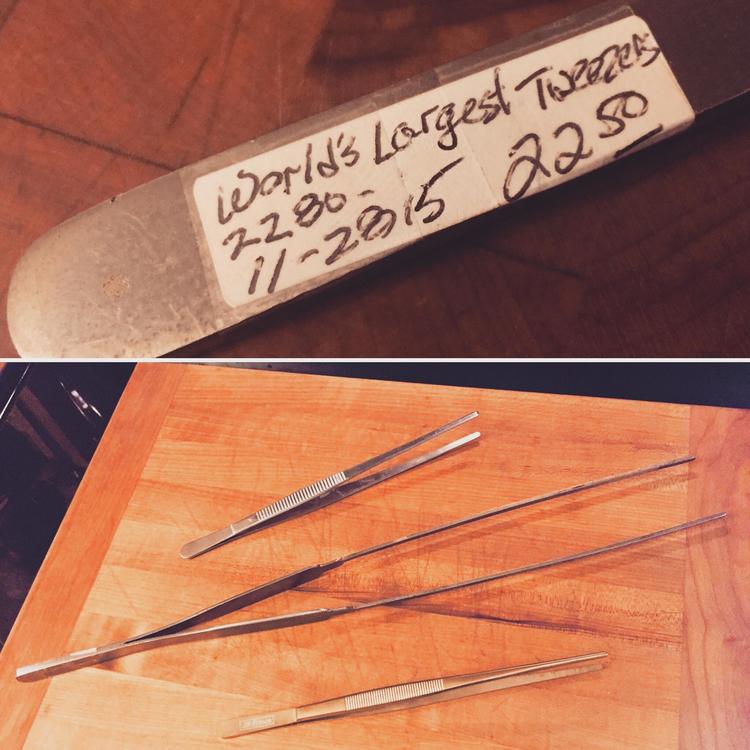-
Posts
1,807 -
Joined
-
Last visited
Content Type
Profiles
Forums
Store
Help Articles
Everything posted by btbyrd
-
If you want some superior broth, make a double stock and then clarify it. The OG way is to use a mixture of pureed chicken breast and egg whites to form a raft. The fancy modernist version uses Methocel F50 instead of egg whites. Either way, the broth won't be the weak link in your wonton soup anymore. You can do the same thing with beef stock if you substitute very lean ground beef for the chicken breast.
-
I mean... it's basically just chicken stock with ginger in it. You can take it in a lot of different directions, but calling it a mother sauce isn't really a fair analogy (if we're comparing it to the 5 classical mother sauces). But you should definitely use it as a starting point and experiment with different variations.
-
I once visited what I thought was a Twilight themed thrift store. Turns out, it was a Hot Topic.
-
I use my "normal" large forceps all the time -- for flipping bacon, manipulating items on my grill, fishing things out of weird places... These forceps are 20" long though... they're as long as my arm, basically. Way overkill for car-crack-fishing or for use with a saute pan. If you could use them successfully to get crap out of rice (or whatever) then your tweezer-fu is stronger than mine. I'm thinking that they might see some use for manipulating hot charcoal (so I can spare my tongs). I'm sure I'll find uses for them. When all you have is a pair of giant tweezers, every problem looks like... a giant unibrow.
-
The steel Global uses is kind of blah. It's durable and plenty stain/rust resistant, but it's on the softer side and is no fun to sharpen. There are other stainless and semi-stainless alloys on the market now that are much better. They're still good knives, but their desirability isn't what it was 15 or 20 years ago when Japanese kitchen knives first broke onto the global market.
-
I have a bunch of Japanese knives, but only one with Damascus cladding. It's purely cosmetic. Blade geometry, grind, and steel type are much more important than how the knife looks (unless you like paying money for shiny things just because they shine how you like them).
-
Apparently they're aquarium tweezers. I didn't know that was a thing. I suppose I overpaid.. Oh well. Giant tweezers...
-
-
Are you using a clay pot? I just ordered a clay Kamado-san donabe rice cooker in hopes that it will vastly improve my rice game.
-
Nice. I always pick up one bottle each of the 10, 16, and 30 year. It is very good. I also stock up on their olive oil and tinned fish when that goes on sale in the summer. Stock that pantry with Zingerman’s sale items.
-
85C is (more or less) where pectin starts to break down and vegetables start to soften. I'm assuming they wanted to basically do a gentle blanch of it while also infusing it with melty buttery goodness. Sounds kind of good, really, given their description...
-
I've done endive before, but not lettuce. At any rate, I'd try 85C until you think the lettuce is close to where you want it to be. Check on it after 20 minutes or so and then every 5 after that until it looks like you imagine it should look.
-
It's the final days of Zingerman's annual balsamic vinegar sale. Get some.
-
Pasteurization is usually only recommended if you're you're going to cook-chill-store or are serving food to people with compromised immune systems. It's not required for cooking SV poultry or for SV cooking generally.
-
@hainanchicken You don't need to pasteurize in the first place unless you have a special reason for wanting to do so.
-
I checked the recipe in Pok Pok, and while it's more detailed (and comes with the story behind the dish) it doesn't explain the rationale behind the process. But from reading the recipe, I think some of the confusion may come from the "marinade" -- which is basically a mix of soy and fish sauce with a bit of sugar and water added in. This "marinade" is to be brushed onto the skin before the last round of drying in the fridge. Since it's brushed on as a surface treatment (to already dried out skin), I don't know that the final "marinade" process runs the risk of waterlogging the skin or undoing all you'd done in the the prior 12-hour drying step. As for including flavors in the brine, it's true that most of the larger flavor particle can't penetrate into the interior of the meat very far, but the skin and the meat just underneath it will benefit. And the salt will still do its magic for the meat deeper down. Brining isn't just insurance against overcooking. It improves the flavor and texture of the final product, and helps the protein hold onto water as it cooks.
-
Depends on the size of the chicken and how you're cooking it. But yes, you can get near-full extraction from legs without hacking them up. If they're super thick or you're concerned for some reason, you can always run a knife down the leg and thigh bones to expose them. But after 45 minutes in the pressure cooker (or a few hours on the stovetop) chicken legs will be falling apart anyway. If you're using low temperatures or short cooking times, smaller pieces will help things infuse quickly. But within "ordinary" chicken stock-making parameters, you'll be cooking for a long enough time that it doesn't much matter.
-
Chicken bones are so small that you can get full extraction without needing to hack them up. Most of the contribution that bones make to broth comes from their collagen, not from the marrow. Bones add "body" or gelatin to the final stock. Marrow is largely fat and doesn't contribute much in the way of flavor. If you've ever made a stock with only bones (and no meat or skin) then you'll know where the flavor is. And it ain't in the bones. Good lord, man... roast those bones! Bone roasting is the difference between lighter, "blonde" chicken stock and the darker, richer roasted chicken stock. They're not really the same product, but I almost never make blonde chicken stock because I prefer the taste from roasted bones. I also find that pre-roasting the bones mostly eliminates the need to blanch and rinse the bones first.
-
I suspect you might be buying flavorless chicken. Do you get better tasting results using traditional methods for Hainan chicken?
-
I was also thinking that breed and processing might make a difference. There's a big difference between the texture of wet and dry chilled chicken, and there's a lot of poultry in the US that has been pre-brined in some way or other.
-

Ruhlman / Dalton Spoons, Utensils, and Kitchen Accessories
btbyrd replied to a topic in Kitchen Consumer
For reference, here are the Ruhlman spoons alongside the Kunz spoons. Apparently Ruhlman used to bend up the Kunz spoons before he had Dalton design the basting/tasting/whatevering pre-bent spoons. There's really nothing to recommend the small, non-strainery Kunz spoon. It's pretty much just a nice, ordinary spoon. The small slotted one is useful for serving olives or pickles or other things packed in brine/oil. The larger slotted one can be useful for serving and plating stuff too. I literally never reach for the non-slotted Kunz spoons unless the Ruhlmans are in short supply. Here's a shot of the small Kunz spoons next to my everyday flatware spoons. The bowl and the edges are slightly nicer, but it feels like a regular spoon. "Meh." Maybe I should give it the DDF / Ruhlman treatment and just bend it myself. -
This stuff is the best I've found of those I've tried.
-
It depends on what I'm going for (and if I use my stovetop pressure cooker or the Instant Pot). There are dishes where the goal is to totally shred the cheeks and add them back to the braising liquid, and those go for a long time (like 45 minutes). For more traditional stew-like things, I'd try 30 minutes for a first pass and see how you like the doneness.
-
I've cooked a fair amount of SV beef cheek. It's closest to short ribs, in terms of ultimate texture at various times/temps. I prefer my SV cheeks like my SV short ribs; 48/72 at 140/130, or else cooked conventionally (or in a pressure cooker). And if you skip the pre-sear, you're not doing yourself any favors.
-
Reminds me of Dave Arnold's Bionic Turkey.






.thumb.jpg.96ee5010313e00d1cfb8ce546476ac55.jpg)
.thumb.jpg.93a23d9d77a8c6f4447209537b826732.jpg)